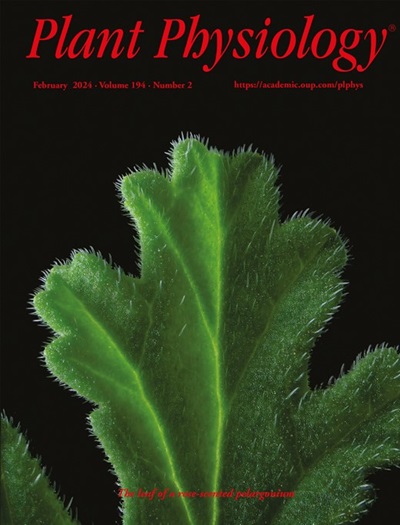Brassinosteroid promotes leaf wrinkling in Brassica campestris by regulating a key transcription factor and its downstream genes
IF 6.5
1区 生物学
Q1 PLANT SCIENCES
引用次数: 0
Abstract
Chinese cabbage (Brassica campestris syn. B.rapa) is an important leafy vegetable featuring a variety of cultivars with diverse leaf morphologies. Among these, leaf wrinkling is a distinctive trait that not only defines cultivar types but also influences key agronomic traits such as light interception, photosynthetic capacity, and consumer preferences related to taste and texture. Despite its importance, the genetic regulation underlying this trait remains unclear. In this study, we compared the transcriptomes of two Chinese cabbage cultivars, ‘Huangya14’ (‘HY14’, with wrinkled leaf) and ‘Suzhouqing’ (‘SZQ’, with flat leaf), at three developmental stages. Clustering analysis suggested that the difference between wrinkled and flat leaves was already apparent 7 days after sowing (DAS). GO and KEGG analysis revealed that a multifaceted network involving adaxial-abaxial axis polarity, epidermal cell division, and brassinosteroid (BR) signaling mediates leaf wrinkling. Notably, the determination of endogenous BR content and exogenous treatment revealed the differentially expressed genes (DEGs) BRASSINAZOLE RESISTANT1 (BcBZR1), PHABULOSA (BcPHB), and CYCLIN D3;1 (BcCYCD3;1), which were further characterized to be sensitive to either endogenous or exogenous BR levels. Overexpression of BcBZR1 and BcPHB contributed to wrinkled leaves with irregular tissue arrangement, increased epidermal cell number, and the elevated expression level of BcCYCD3;1. Meanwhile, silencing the two genes reduced the degree of leaf wrinkling. Interestingly, Y1H, dual-LUC, and ChIP-qPCR assays revealed that BcBZR1 specifically binds to the promoter of BcPHB and BcCYCD3;1 to activate their expression, and BcPHB also promoted the expression of BcCYCD3;1. This study unveils a mechanism whereby BR contributes to leaf wrinkling in Chinese cabbage by regulating the key component BcBZR1 and its downstream genes BcPHB and BcCYCD3;1.油菜素内酯通过调控一个关键转录因子及其下游基因促进油菜叶片起皱
白菜(Brassica campestris syn. B.rapa)是一种重要的叶菜,品种繁多,叶形态各异。其中,叶片起皱是一种独特的性状,它不仅决定了品种类型,而且影响了关键的农艺性状,如抗光能力、光合能力以及与口感和质地相关的消费者偏好。尽管它很重要,但这种特性背后的遗传调控机制仍不清楚。在本研究中,我们比较了两个大白菜品种黄芽14 (‘ HY14 ‘,皱叶)和苏州青(’ SZQ ’,平叶)在三个发育阶段的转录组。聚类分析表明,在播种后7 d,皱叶与平叶的差异已经很明显。GO和KEGG分析显示,一个涉及近轴-背轴极性、表皮细胞分裂和油菜素内酯(BR)信号传导的多面网络介导了叶片起皱。值得注意的是,内源性BR含量和外源性处理的测定揭示了差异表达基因(DEGs) BRASSINAZOLE RESISTANT1 (BcBZR1)、PHABULOSA (BcPHB)和CYCLIN D3;1 (BcCYCD3;1),进一步表征了它们对内源性或外源性BR水平都敏感。BcBZR1和BcPHB的过表达导致叶片皱褶,组织排列不规则,表皮细胞数量增加,BcCYCD3表达水平升高;同时,沉默这两个基因可以降低叶片褶皱的程度。有趣的是,Y1H、dual-LUC和ChIP-qPCR检测显示BcBZR1特异性结合BcPHB和BcCYCD3;1的启动子激活它们的表达,BcPHB也促进BcCYCD3;1的表达。本研究揭示了BR通过调控关键成分BcBZR1及其下游基因BcPHB和BcCYCD3参与大白菜叶片起皱的机制;
本文章由计算机程序翻译,如有差异,请以英文原文为准。
求助全文
约1分钟内获得全文
求助全文
来源期刊

Plant Physiology
生物-植物科学
CiteScore
12.20
自引率
5.40%
发文量
535
审稿时长
2.3 months
期刊介绍:
Plant Physiology® is a distinguished and highly respected journal with a rich history dating back to its establishment in 1926. It stands as a leading international publication in the field of plant biology, covering a comprehensive range of topics from the molecular and structural aspects of plant life to systems biology and ecophysiology. Recognized as the most highly cited journal in plant sciences, Plant Physiology® is a testament to its commitment to excellence and the dissemination of groundbreaking research.
As the official publication of the American Society of Plant Biologists, Plant Physiology® upholds rigorous peer-review standards, ensuring that the scientific community receives the highest quality research. The journal releases 12 issues annually, providing a steady stream of new findings and insights to its readership.
 求助内容:
求助内容: 应助结果提醒方式:
应助结果提醒方式:


